Tom's Hardware Verdict
Philips' Momentum 559M1RYV delivers an excellent jumbo-screen experience for gaming and entertainment. Its only flaw is a weak overdrive, but with a vivid picture, accurate color, killer HDR, top-quality sound and Ambiglow, it has some worthwhile advantages over a television.
Pros
- +
+ Bright, sharp picture & broad contrast
- +
+ Vivid, accurate color with excellent HDR
- +
+ Versatile Ambiglow bias light feature
- +
+ Class-leading audio quality
- +
+ Solid build
Cons
- -
Mediocre overdrive
- -
No ULMB backlight strobe
Why you can trust Tom's Hardware
The Philips Momentum 559M1RYV is a beast, both in size and features. Its 55-inch 4K (or UHD) VA panel sports a 144Hz refresh rate, Adaptive-Sync, HDR, extended color and a 1200-nit full-array backlight. It also includes a slick bias light feature and, as one of the first monitors released under Microsoft’s “Designed for Xbox” partner program, is optimized for the latest Xbox console.
Jumbo panels blur the lines between computer monitors and televisions. If you stick with a TV, you can enjoy a cheaper but potentially less feature-rich big screen experience. But if you get a jumbo monitor, you’re more likely to get additional features like a fast refresh rate, DisplayPort connectivity and Adaptive-Sync. Either way, there’s nothing like gaming on a huge display, something that the Philips Momentum 559M1RYV easily demonstrates.
Philips probably isn’t the first name you think of when it comes to gaming monitors, but it makes some very capable display products. There are currently two 55-inch displays in its jumbo category, the Momentum 558M1RY we reviewed earlier this year and its Xbox-certified cousin, the Momentum 559M1RYV we're testing here. Both use VA panels running at a 4K resolution with DisplayHDR 1000, extended color and adaptive sync. The newer model adds a 144Hz refresh rate, Xbox-specific picture modes, HDMI 2.1 and higher contrast thanks to a 144-zone full-array backlight.
Philips Momentum 559M1RYV Specs
| Panel Type / Backlight | VA / W-LED FALD |
| Row 1 - Cell 0 | 144 dimming zones |
| Screen Size / Aspect Ratio | 55 inches / 16:9 |
| Max Resolution & Refresh Rate | 3840x2160 @ 144Hz |
| Row 4 - Cell 0 | FreeSync: 48-144Hz |
| Row 5 - Cell 0 | G-Sync Compatible |
| Native Color Depth & Gamut | 10-bit / DCI-P3 |
| Row 7 - Cell 0 | HDR10, DisplayHDR 1000 |
| Response Time (GTG) | 4ms |
| Brightness (mfr) | 750 nits SDR |
| Row 10 - Cell 0 | 1,200 nits HDR |
| Contrast (mfr) | 4,000:1 |
| Speakers | B&W sound bar |
| Row 13 - Cell 0 | 2.1 channel, 40 watts total |
| Video Inputs | 1x DisplayPort 1.4 |
| Row 15 - Cell 0 | 3x HDMI 2.1 |
| Row 16 - Cell 0 | 1x USB-C |
| Audio | 3.5mm headphone output |
| USB 3.2 | 1x up, 4x down (2x w/ power) |
| Power Consumption | 68w, brightness @ 200 nits |
| Panel Dimensions WxHxD w/base | 48.5 x 32.8 x 12.1 inches (1232 x 833 x 307mm) |
| Panel Thickness | 4 inches (102mm) |
| Bezel Width | Top/sides: 0.5 inch (12mm) |
| Row 23 - Cell 0 | Bottom: 0.9 inch (22mm) |
| Weight | 64.9 pounds (29.5kg) |
| Warranty | 4 years |
The 559M1RYV's VA panel is rated for 4,000:1 contrast natively. We measured slightly higher numbers in our tests and very impressive results for HDR. A 1,200-nit FALD backlight with 144 dimming zones helps broaden dynamic range with HDR contrast that tops 200,000:1, as confirmed by our tests. There's also a wide color gamut which covers over 90% of the DCI-P3 color space. That color is accurate, too, and you can easily enjoy the 559M1RYV without calibration if you like.
Gamers will appreciate the inclusion of the HDMI 2.1 standard, which lets you run Xbox and PS5 consoles with FreeSync at 120Hz in UHD resolution. These features are a big selling point here, as the 559M1RYV is one of Microsoft’s first Xbox certified displays.
PC users can also up the speed to 144Hz through both HDMI and DisplayPort 1.4. You also get a USB-C port, which mimics DisplayPort functions and provides 65 watts of power to charge peripherals. Philips didn’t skimp on USB ports either, with four downstream USB 3.2 Type-A ports. Two of them also provide extra juice for charging devices.
And Philips hasn't cut corners on amenities. A Bowers & Wilkins soundbar is permanently installed on the substantial stand, providing high-quality audio in a 2.1 channel configuration, with 40 watts total power. The subwoofer channel includes a port, which is a carefully shaped hole in the speaker cabinet that extends bass frequencies to lower registers. This is a feature often found on high-end subwoofers and large speakers. While a good dedicated speaker setup will provide better sound, you'll be hard-pressed to find better sound included with a computer display, or a television for that matter.
Get Tom's Hardware's best news and in-depth reviews, straight to your inbox.
Philips’ other unique feature is its Ambiglow lighting array. Rather than the cosmetic LEDs found on many gaming monitors, Ambiglow is a truly useful accessory that can function as either a bias light or as an enhancement to gaming. It comes with a myriad of effects that can flash, breathe, pulse or even follow/mimic the onscreen action. And you don’t need additional software to run it. Its AI is entirely firmware-based.
Is the $1,599 559M1RYV more expensive than a comparably sized TV? Yes, but not significantly. The display offers a few advantages over a television and can function as one as long as you don’t need an internal tuner. For gamers specifically, it offers a lot of compelling features with solid performance. Let’s take a closer look.
Assembly and Accessories
The 559M1RYV arrives in a large TV-style box that’s held shut by plastic plugs. Take them out and the top lifts off to reveal an assembled display with the stand and sound bar already in place. It’s just a plug and play affair— simply insert the the enclosed IEC power cord into your wall. You also get 1 USB-C port, 4 USB-A ports, a single USB-B connection, DisplayPort and HDMI cables. Four large lugs provide the means to attach aftermarket brackets to the 200mm VESA mount once you remove the stand. And, of course, there’s the all-important remote. Since this monitor might as well be a TV, you’ll want that to control all your monitor functions.
Product 360
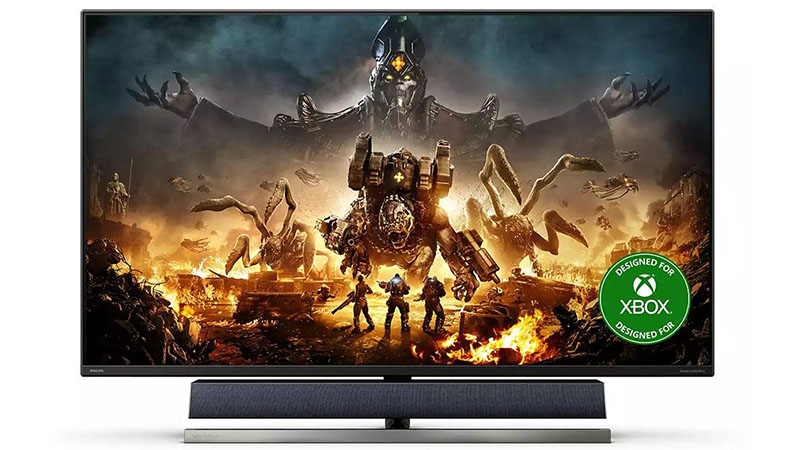
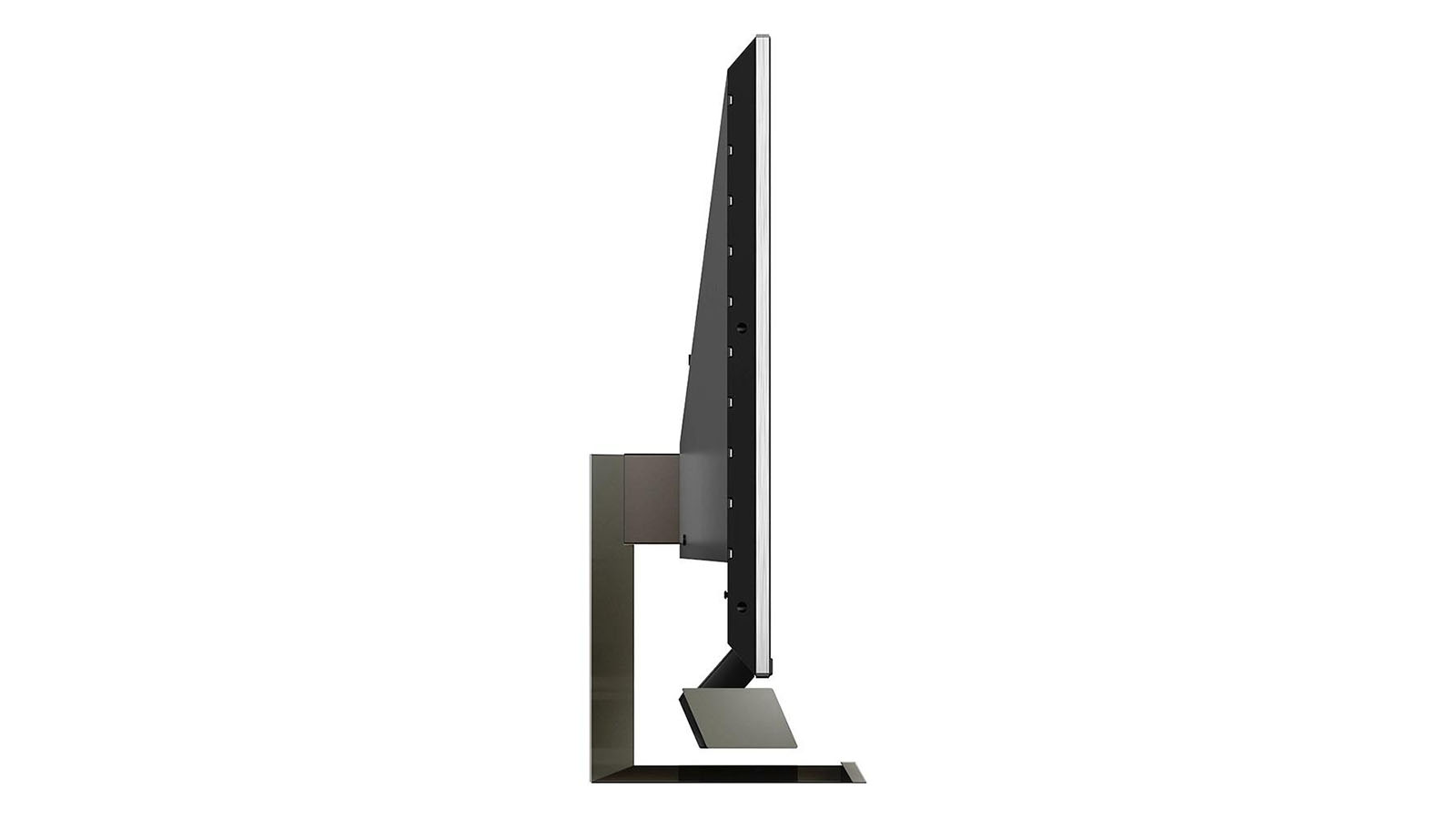

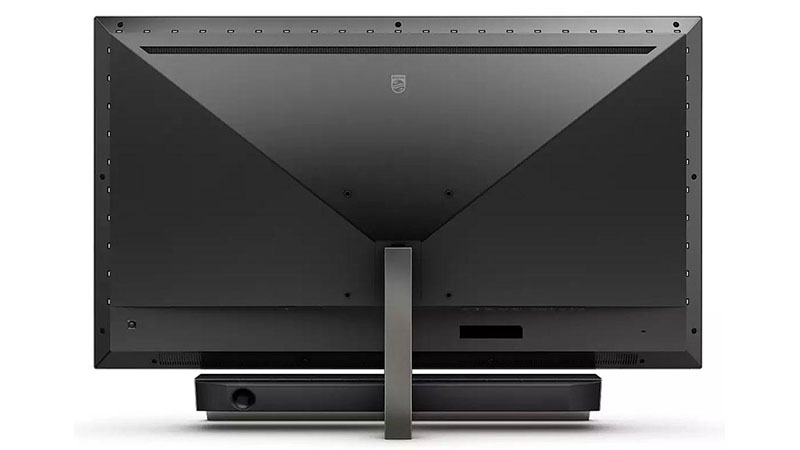

The 559M1RYV is styled a bit like a vintage television— vintage 2000s, that is. True, it sports the thin flush bezel found on most LCDs today and has matte-black plastic across its back. But there is brushed metal surrounding the edge that sets this monitor apart from other brands. The base is also metal, with a fine pebble-grain finish. The soundbar is suspended between the panel and base and is covered with coarse woven fabric. It has a bass port in the back that extends low frequencies into the more tactile range below 100Hz. Behind the fabric is a status light that glows red in standby mode.
In back, you can see Philips’ Ambiglow LEDs around the top and sides. Again, these shine light behind your screen to provide either extra contrast or extra gaming atmosphere. They are not covered by diffusers, so they can shine very brightly if desired. In addition to having a multitude of colors and effects, they can also serve as a built-in bias light. This is a feature that no other brand offers in their monitors. A bias light can improve your perception of contrast and sharpness by closing the eyes’ iris. When properly configured, the effect is not only pleasing, but it reduces eye fatigue. We’ll talk more about this in the Hands-On observations below.
The soundbar contains two tweeters, two midrange drivers and a woofer with 40 watts total power. It’s B&W branded, has DTS sound enhancement and sounds amazing for something built into a TV. The sense of space and depth is an order of magnitude better than any other built-in solution I’ve experienced. The OSD has a huge section devoted to sound modes and adjustments, including a five-band equalizer.
The stand is solid, with a wide and deep base and a single upright. It can be removed if you plan to wall mount. It offers -5 and 10 degrees of tilt should you place the 559M1RYV on a bench or stand lower than your eyepoint.
The remote is small and lacks a backlight but is borderline essential for OSD navigation, as you’ll probably be using this monitor from far enough away that you won’t want to use the joystick located behind its lower right side. Source selection and volume control are accessible from the remote, and it also has a rocker switch for brightness adjustments and one-touch keys for both picture mode and Ambiglow.
The input panel is up and under, like most computer monitors, and is fully stocked with the latest interfaces. In addition to one upstream and four downstream USB 3.2 ports, there’s a USB-C input that mimics DisplayPort functions up to 120Hz and provides 65 watts of charging power. Two of the USB 3.2 ports also provide extra juice. For video connections, you get three HDMI 2.1 ports and one DisplayPort 1.4 connection. All support HDR and Adaptive-Sync up to 144Hz. The HDMI ports can be switched to 120Hz individually to accommodate console systems (which don’t yet support 144Hz).
OSD Features
Pressing the center key on the 559M1RYV’s remote brings up a large OSD that can be easily read from across the room. It can be moved to any part of the screen to accommodate color meters. You can also control the menu with a tiny joystick behind the right side of the panel.
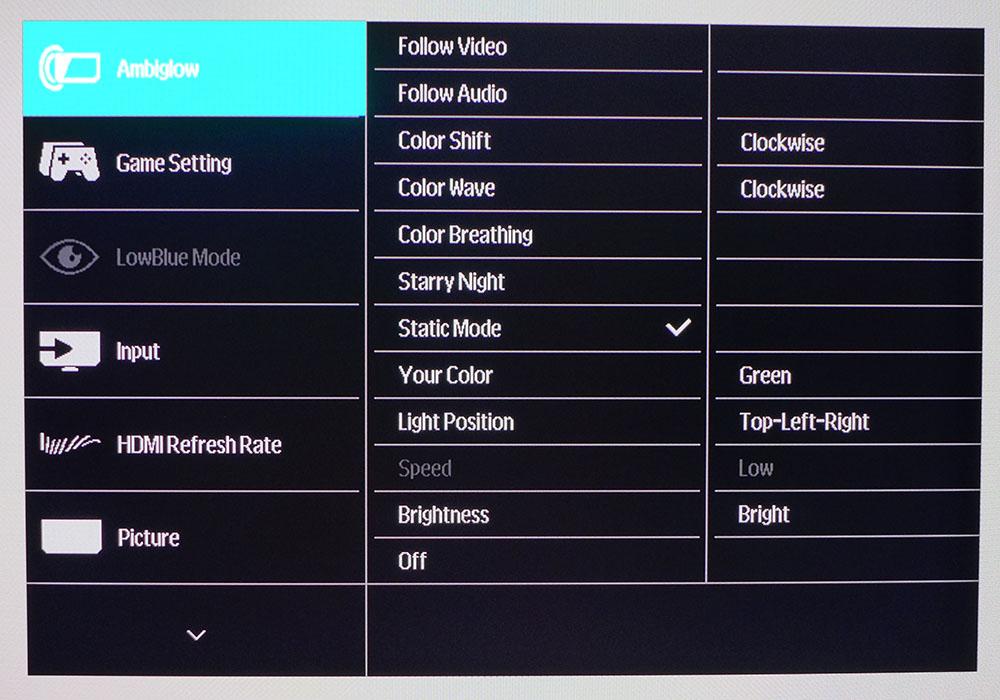
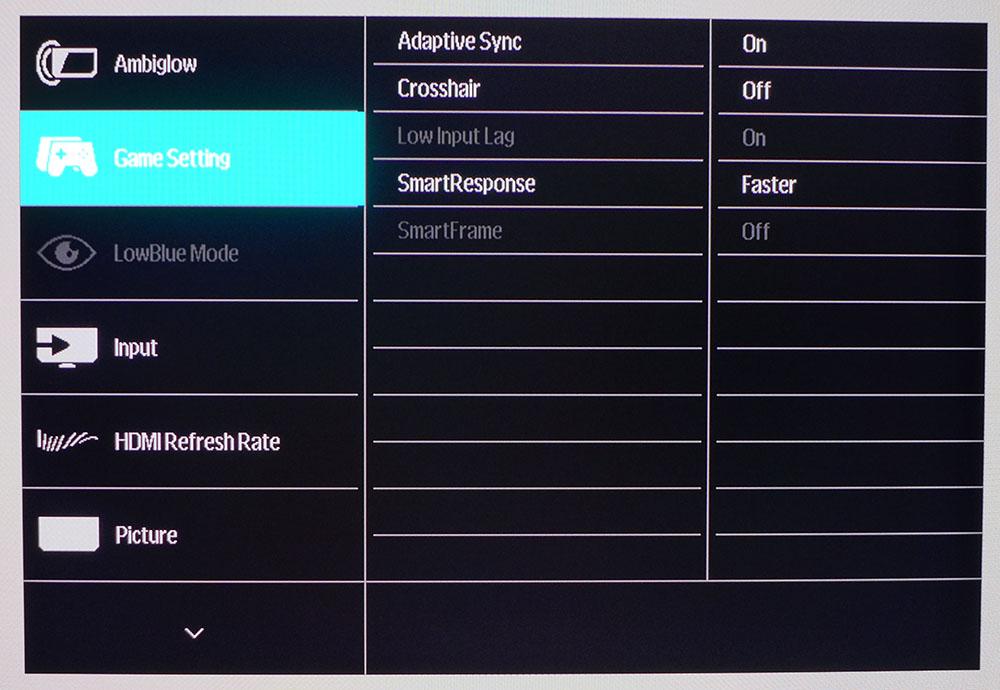
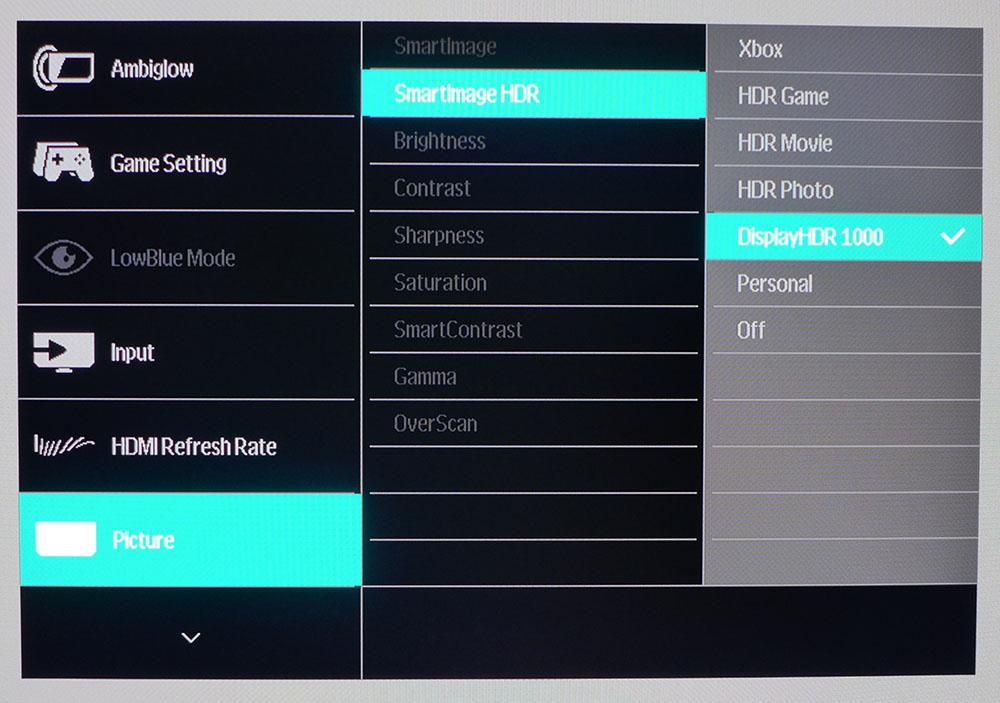



The Ambiglow menu has a vast number of options for colors and effects. You can have the lights change according to video content, audio or both. You can also set one color to consistently shift, wave or breathe. Alternately, you can select a static color, including a special Xbox green. To use Ambiglow as a bias light, choose white and a brightness level that’s around 10% of the screen’s peak brightness. If you calibrate to 200 nits, use the lowest setting for Ambiglow. The light reflecting from the wall behind will increase the user’s perception of contrast and sharpness. This is a process backed by science and is a feature commonly used in professional video editing suites. It’s also great for home entertainment when watching or playing in darkened rooms.
Game settings include an Adaptive-Sync toggle, aiming point (think a crosshair), a low input lag mode for HDMI inputs and SmartResponse, a three-level overdrive. The latter isn’t as effective as many others we’ve used. Blur is reduced slightly, but even on the fastest setting, there is still some smear. There isn’t any ghosting, though, which means fast gaming is relatively smooth. You will want to keep frame rates high for the best possible image quality.
The SmartImage option houses the 559M1RYV’s set of picture modes, with seven options for HDR content and 10 for SDR content. DisplayHDR 1000 is the best option for HDR games and video, as it uses the backlight’s full brightness and has an aggressive dynamic feature that takes HDR contrast to over 200,000:1. The Xbox mode was a bit confusing for me. Xbox consoles use the same HDR10 standard as any other HDR video source, so there is no reason to use a different mode just for the Xbox. In our tests, this proved very washed out and flat. Stick with DisplayHDR 1000 for all HDR content. SDR modes are also numerous, but we found the best picture with SmartImage turned off. It allows calibration, which isn’t strictly necessary but does provide a visible improvement in quality.
Also in the Picture menu is SmartContrast, which engages the local dimming feature in the 144-zone backlight. It’s very effective in HDR mode, but for SDR content, we found it too aggressive. It crushed shadow detail in some of the games we played. It also lags a bit as picture content changes, which causes pumping as the backlight tries to keep up.
Audio modes are almost as numerous as picture options. Sport & Racing is good for all types of games. If you listen to music, Music mode provides a wide soundstage with good channel separation. If you want to create your own mode, Personal mode unlocks a five-band equalizer.
To calibrate your screen, you can choose from preset color temps by Kelvin value, tweak a set of RGB sliders, or use sRGB for SDR material. sRGB mode shrinks the gamut correctly, with a D65 white point and 2.2 gamma. It locks brightness at a high level, though, which makes it difficult to use in dark rooms.
Philips 559M1RYV Calibration Settings
You can use the 559M1RYV without calibration and with SmartImage turned off. This employs the monitor’s full native gamut, which is just over 90% of the DCI-P3 color space. If you want sRGB, that option is found in the Color Temp menu. The user color temp option unlocks a precise set of RGB sliders, which can be used to achieve a high level of accuracy. Our recommended settings are below.
For HDR material, there are no calibration options, but you do get seven picture modes. Our tests showed DisplayHDR 1000 to be the best choice.
| Picture Mode | Smart Image Off |
| Brightness 200 nits | 48 |
| Brightness 120 nits | 4 |
| Brightness 100 nits | 0 |
| Contrast | 50 |
| Gamma | 2.4 |
| Color Temp User | Red 92, Green 100, Blue 96 |
Gaming and Hands-on
Using a 55-inch screen for general computing tasks takes some adaptation. You can sit close without seeing the pixel structure, although density is just 80ppi. But if you can see the pixels, you’ll also see a dimmer picture at the sides of the screen. The ideal viewing distance is about seven feet. Five feet works, but we had to turn our heads too much to see multiple documents at that position.
Windows defaults to a 300% font scaling setting, which is fine up to about 10 feet. With this scaling, you can clearly see small type and icons with no visible anti-aliasing or artifacts. The picture is clean and sharp with no change in tone or uniformity from edge to edge. There is no grain from the anti-glare layer either. Speaking of that, this monitor effectively prevented reflections from small light sources like table lamps.
Ambiglow is something that may be worth buying a Philips monitor for. It’s a truly useful lighting feature that is not just cosmetic. Yes, it was fun to watch the colors shift with on-screen content and with the soundtrack, but when I used it as a bias light, it enhanced gaming significantly. By dimming the room lights a bit and setting Ambiglow to a soft white steady state, it made the image look sharper, deeper and more colorful. I am not aware of another monitor brand that includes this feature. While you can add a bias light LED strip to any panel for around $50, you’ll have to install it yourself. And it won’t have the neat ability to play colors and effects with audio and video in real time the way Ambiglow can.
Moving on to games, I jumped right into Doom Eternal and its killer HDR mode. With a few tweaks in the game’s menu, I saw super-saturated color and a sense of depth that was tactile (meaning some objects looked like I could reach out and touch them). Metal and stone textures were especially realistic, as were reflections. Primary colors were also far more vivid than their SDR counterparts.
Rise of the Tomb Raider showed much the same look, even though it’s an SDR game. Extra color almost always improves this title’s look. We tried the SmartContrast option for a bit, but found it made shadow detail too hard to see. It’s best left off for all SDR material.
Call of Duty WWII also has terrific HDR on this monitor after a few tweaks in the game’s menu. Outdoor scenes were drenched in sunlight that glinted off sweat and shiny metal alike. Greens and blues were lush and natural, and flesh tones weren’t too ruddy or overblown.
Video processing was excellent for the most part. Our only complaint was the weak overdrive. It can be used on its fastest setting without ghosting, but it doesn’t do enough to combat motion blur. Keeping framerates high is a must. Anything below 80fps shows smearing and blur, especially in objects with vertical lines like buildings or fences. Adaptive-Sync worked flawlessly on both Nvidia and AMD platforms in SDR and HDR modes. We never saw any color banding. With a better overdrive, the 559M1RYV would be a leading gaming monitor. As it stands here, it’s just very good.
I also hooked up a Blu-ray player to test video compatibility. The 559M1RYV supports 24p film cadence from discs and from streamed content. That means it can properly execute all the functions of a television and is compatible with every signal format used in video and gaming. That’s a definite plus.
Current page: Features and Specifications
Next Page Response, Input Lag, Viewing Angles and Uniformity
Christian Eberle is a Contributing Editor for Tom's Hardware US. He's a veteran reviewer of A/V equipment, specializing in monitors. Christian began his obsession with tech when he built his first PC in 1991, a 286 running DOS 3.0 at a blazing 12MHz. In 2006, he undertook training from the Imaging Science Foundation in video calibration and testing and thus started a passion for precise imaging that persists to this day. He is also a professional musician with a degree from the New England Conservatory as a classical bassoonist which he used to good effect as a performer with the West Point Army Band from 1987 to 2013. He enjoys watching movies and listening to high-end audio in his custom-built home theater and can be seen riding trails near his home on a race-ready ICE VTX recumbent trike. Christian enjoys the endless summer in Florida where he lives with his wife and Chihuahua and plays with orchestras around the state.